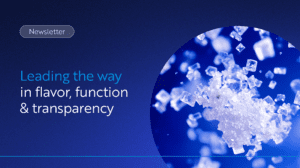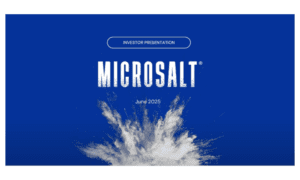Many food manufacturers would be out of business without sodium – and consumers would be at increased risk of serious illness.
Key Takeaways:
- Dangerous yeast and bacteria can’t thrive in the presence of sodium
- Sodium limits water content and prevents microbial growth
- Sodium in food promotes protein binding
- Sodium preserves flavor and texture
It’s essential that we continue to increase public awareness of the dangers of too much dietary sodium, particularly how it can affect our weight and negatively impact our children. But it’s equally important that sodium doesn’t become solely associated with health risks. In the right amounts (and here are those numbers), sodium plays an essential role in physical functions like regulating heart rhythm, contracting and relaxing muscles, and balancing body fluid levels.
Sodium is also an important ingredient in food manufacturing because it helps make food safe for storage and consumption. Read on to learn about sodium’s strengths and limitations in food preservation.
Sodium fights harmful bacteria
Sodium can limit the water content in food, and less water means fewer opportunities for bacteria like Salmonella or Clostridium botulinum (the cause of botulism) to find a place to set up shop and multiply. These tiny organisms rely on water as a source of nutrition by drawing it across the cell membrane via osmosis. That’s harder for them to do wherever sodium dehydrates foods.
When the amount of available water outside the cell becomes too low for effective osmosis, these harmful microorganisms fall into a dormant state. The impact on their DNA and enzymes renders them incapable of the level of growth that can lead to infection in humans. Sodium won’t stop all bacteria, however. There’s an entire group of microorganisms, known as halophiles, that thrive in high-salt environments (their name literally means “sodium loving”).
But salt’s effectiveness at protecting food from most harmful bacteria is why sodium has been used for centuries to cure and preserve meats, which keeps them edible for long periods. Even dairy products like butter can be preserved using sodium since just the fat is left behind after dehydration.
Sodium also plays a role in the fermentation process used to make foods like bread, sauerkraut, and cheese. Adding different levels of sodium during production helps manufacturers keep yeast and mold under control, limit lactic acid reactions, and promote the growth of selected flora.
Sodium’s role in protein binding
The term “protein binding” is a little misleading. The process involves removing sodium-soluble proteins from formed and processed meats, allowing the meat to bind together more successfully. This effect boosts the meat’s ability to retain water during cooking.
This added water helps combat the shrinkage meat undergoes at temperatures that cause connective tissues and muscle fibers to contract (the process that makes overcooked meat turn tough). Without protein binding, your favorite cooked meat meals wouldn’t be nearly as tender.
A meat’s stability also depends on how effectively it bonds with fat emulsions. Can you guess what helps that happen? That’s right – sodium! Sodium-soluble proteins bind with fat particles to effectively create a glue that prevents the meat from falling to pieces.
Sodium as a texture and color enhancer
Sodium can also promote some desired toughness in food, such as when it’s used in bread to increase its strength. Sodium tightens the gluten protein, making it easier for dough to retain the carbon dioxide necessary for maintaining a loaf’s structure during fermentation.
The result is loaves that don’t come apart when expanding in the oven and keep the texture they need for a crisp or crunchy exterior. The rich, golden color of some bread crusts is a visual gift from added sodium, which helps maintain sugar levels as they react with amino acids.
Now think of some meat treats with a particular shape, like hot dogs or deli meats. Sodium imparts the necessary firmness and smoothness for them to maintain that shape and texture (it’s meat science). The color of processed meat is also due to sodium working in tandem with nitrates and sugar or nitrites and sugar.
Cheese and sodium have an essential relationship
The tough rind on many popular cheeses like Brie and Camembert wouldn’t be possible without adding sodium. Cheese also comes in many textures, from moist to brittle – characteristics that depend on the amount of sodium used in the mix and the resulting level of dehydration.
Some enzymes and microbes are more welcome in the cheesemaking process than elsewhere. The delicate balance of sodium is what allows the right amount of growth to create the desired flavor. Cheesemakers use one of three methods to get salt into their product:
- Dry salting – A two-step process where salt is first added to the curd, then again when the coagulated milk has been cooked and drained.
- Dry rub salting – Adding salt to cheese that has already been formed, then rubbing it into the surface.
- Brine salting – A longer process that involves submerging cheese in a salt-brine solution, which allows the liquid to slowly seep in.
Isn’t it interesting how much salt does for us behind the scenes? And now that you know, there are some important steps you can take to ensure salt’s services aren’t in vain.
Play your part in helping salt keep you safe
Just as we began this blog in defense of sodium, we must end it on a note of caution. Sodium can be instrumental in controlling bacteria, but it doesn’t eliminate them; it only slows them down. Food poisoning is still a possibility – one that’s increased by poor food preparation and storage practices. Always make sure to refrigerate your food for added antibacterial protection and to cook it responsibly.
Reach out to MicroSalt® for a new kind of sodium
We’ve created a revolutionary, all-natural microparticle that delivers twice the salty flavor but with only half the sodium. It’s our way of contributing to a healthier world by showing food manufacturers how to revolutionize their production processes and helping consumers embrace a flavorful low-sodium lifestyle. You can contact us via our message page or call 1-877-825-0655 to learn more!




